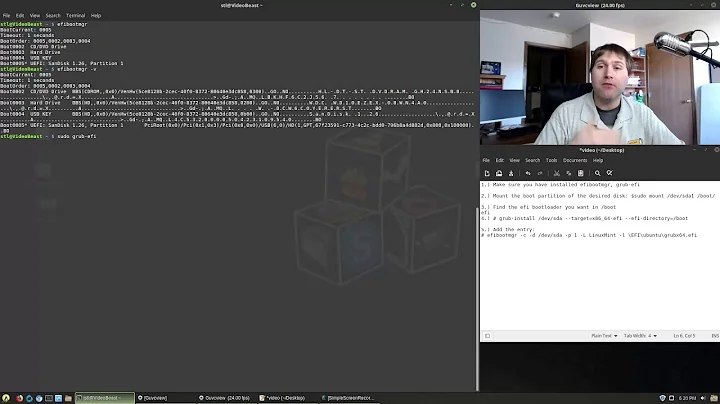grub2-install: error: /boot/efi doesn't look like an EFI partition on a fresh Gentoo install
Solution 1
The problem seemed to be mixing and matching BIOS, EFI, MBR, and GPT. I tried to follow the guides and use the GPT, but there were some dependencies that I could not resolve because I am too inexperienced. Its not even clear to me the kernel was built with GPT support (via config option CONFIG_EFI_PARTITION).
When I dropped GPT and EFI and switched to purely BIOS and MBR, I was able to boot the resulting machine. BIOS and GPT are supposed to be a valid combination, but I'm wondering if it works in practice (see, for example, Bootloader Options).
Here's the configuration I was able to run the machine with:
$ parted
GNU Parted 3.2
Using /dev/sda
(parted) print
Model: ATA VMware Virtual I (scsi)
Disk /dev/sda: 21.5GB
Sector size (logical/physical): 512B/512B
Partition Table: msdos
Disk Flags:
Number Start End Size Type File system Flags
1 1049kB 135MB 134MB primary ext2 boot
2 135MB 19.5GB 19.3GB primary ext4
3 19.5GB 21.5GB 2012MB primary linux-swap(v1)
Partition 1 is /boot, Partition 2 is /, and Partition 3 is swap.
Solution 2
The answer is simple. EFI System Partition (ESP) should be FAT32 (FAT16 or even FAT12 will also do for most proper UEFI; they are mostly shown as vfat in Linux) instead of ext2:
mkfs.fat -F32 /dev/sda2
FWIW, if you are not going to install grub i386-pc (for BIOS/CSM boot), you don't need the "BIOS boot" partition. It is only required by grub i386-pc (but not grub x86_64-efi or i386-efi) on GPT.
It doesn't really matter whether you use the ESP for /boot. If you do, you should run:
grub2-install --efi-directory /boot
If you mount it on /boot/efi instead, then you should run:
grub2-install --efi-directory /boot/efi
--boot-directory /boot is implied (i.e. default); It doesn't matter whether /boot is the ESP, another separate partition, or a directory on the / filesystem.
You may not even need to chroot again to perform grub2-install; For example, you mounted sda4, your partition for /, on /mnt; AND THEN, mounted sda2, your ESP, on /mnt/boot/efi, then you can simply run:
grub2-install --boot-directory /mnt/boot --efi-directory /mnt/boot/efi
Although grub2-mkconfig needs to be run in chroot AFAIK. But if you plan on writing a simple and clean grub.cfg yourself instead (which is the only graceful way to use grub2), then this will be out of your concern.
Solution 3
I just had this issue and found that /boot existed but didn't have my boot partition mounted to it. Just had to mount the boot partition to fix this
mnt /dev/sda1 /boot
Solution 4
If you are installing this on virtual-box make sure you have the enabled the option of EFI under the category of Setting/System
Related videos on Youtube
jww
Updated on September 18, 2022Comments
-
 jww over 1 year
jww over 1 yearI need a Gentoo 13 machine to test some software on the platform. I'm not a Gentoo regular, so I'm suffering their install procedures. I'm at Configuring the bootloader | Installing GRUB2, and it failed with:
# grub2-install --target=x86_64-efi --efi-directory=/boot Installing for x86_64-efi platform. grub2-install: error: /boot doesn't look like an EFI partition.I backtracked to Preparing the disks | Default: Using parted to partition the disk, and it appears I have things setup as instructed:
(chroot) Gentoo-2012 / # parted GNU Parted 3.2 Using /dev/sda Welcome to GNU Parted! Type 'help' to view a list of commands. (parted) unit mb (parted) print Model: ATA VMware Virtual I (scsi) Disk /dev/sda: 21475MB Sector size (logical/physical): 512B/512B Partition Table: gpt Disk Flags: Number Start End Size File system Name Flags 1 1.05MB 3.15MB 2.10MB grub bios_grub 2 3.15MB 131MB 128MB ext2 boot boot, esp 3 131MB 2572MB 2441MB linux-swap(v1) swap msftdata 4 2572MB 21474MB 18902MB ext4 rootfs msftdataThe results above are from the same chapter of the manual, sections Applying a filesystem to a partition and Activating the swap partition.
I also followed the comment EFI directory should not be /boot but /boot/efi from Bootloader problems and questions on the Gentoo forums, but it resulted in the same error:
(chroot) Gentoo-2012 / # mkdir /boot/efi (chroot) Gentoo-2012 / # grub2-install --target=x86_64-efi --boot-directory=/boot --efi-directory=/boot/efi Installing for x86_64-efi platform. grub2-install: error: /boot/efi doesn't look like an EFI partition.What's the problem and how do I fix it?
Here's the corresponding
fdiskview of the information presented bygpartedabove.(chroot) Gentoo-2012 / # fdisk -l Disk /dev/loop0: 3.3 GiB, 3567640576 bytes, 6968048 sectors Units: sectors of 1 * 512 = 512 bytes Sector size (logical/physical): 512 bytes / 512 bytes I/O size (minimum/optimal): 512 bytes / 512 bytes Disk /dev/sda: 20 GiB, 21474836480 bytes, 41943040 sectors Units: sectors of 1 * 512 = 512 bytes Sector size (logical/physical): 512 bytes / 512 bytes I/O size (minimum/optimal): 512 bytes / 512 bytes Disklabel type: gpt Disk identifier: 52F5571A-808B-XXXX-XXXX-XXXXXXXX Device Start End Sectors Size Type /dev/sda1 2048 6143 4096 2M BIOS boot /dev/sda2 6144 255999 249856 122M EFI System /dev/sda3 256000 5023743 4767744 2.3G Microsoft basic data /dev/sda4 5023744 41940991 36917248 17.6G Microsoft basic data
I also verified the package
sys-boot/grubsupports EFI:(chroot) Gentoo-2012 / # cat /etc/portage/make.conf | grep GRUB GRUB_PLATFORMS="emu efi-32 efi-64 pc"I then performed an
emerge --ask --newuse sys-boot/grub,emerge -pv sys-boot/grub, and then rebuiltgrub. -
 jww about 8 yearsThanks Tom. It looks like their manual is pretty much broken in this area. Let me try some of these things and get back to you.
jww about 8 yearsThanks Tom. It looks like their manual is pretty much broken in this area. Let me try some of these things and get back to you. -
 jww about 8 yearsThanks again Tom. I performed the
jww about 8 yearsThanks again Tom. I performed themkfs.fat -F32 /dev/sda2. I mounted things again as per the manual, and I was able to rungrub2-install --target=x86_64-efi --boot-directory=/boot --efi-directory=/boot/efi/with some warnings.grub2-installcompleted with "Installation finished. No error reported." However, it does not boot, and produces an error "operating system not found". No wonder these guys don't produce a LiveCD that performs an installation. Based on their instructions, it can't be done. -
Tom Yan about 8 yearsAs per the manual? What does that mean? Tell the
mountcommands you ran IN ORDER. Also considering the params you used, have you chrooted? Usually you can't really ignore "warnings" fromgrub2-install, so please show what exactly they are. -
 jww about 8 yearsThanks again Tom. Sorry about that; I thought you were familiar with the procedures. The disks were mounted according to Preparing the disks | Mounting. Chroot was entered according to Installing the Gentoo base system | Mounting the necessary filesystems. I had to Chroot because I got an error without it. The error was "grub2-install: error: /usr/lib/grub/x86_64-efi/modinfo.sh doesn't exist."
jww about 8 yearsThanks again Tom. Sorry about that; I thought you were familiar with the procedures. The disks were mounted according to Preparing the disks | Mounting. Chroot was entered according to Installing the Gentoo base system | Mounting the necessary filesystems. I had to Chroot because I got an error without it. The error was "grub2-install: error: /usr/lib/grub/x86_64-efi/modinfo.sh doesn't exist." -
Tom Yan about 8 yearsIt's not about the "procedures" or whether I am familiar with them. It's HOW YOU mounted YOUR devices. So did you
mount /dev/sda4 /mnt/gentoo; mount /dev/sda2 /mnt/gentoo/boot/efiin this ORDER and chroot to/mnt/gentoo? Again, what were the warnings you mentioned? -
Tom Yan about 8 yearsIt's not totally surprising that you can't do it outside chroot. I guess gentoo's iso does not have a full set of grub prepared for you.
-
 jww about 8 yearsTom, the output from running
jww about 8 yearsTom, the output from runninggrub2-installwas "Installing for x86_64-efi platform.\n efibootmgr: EFI variables are not supported on this system.\n efibootmgr: EFI variables are not supported on this system.\n Installation finished. No error reported." The one message was reported twice, and I added the "\n" to show where the line breaks were. -
Tom Yan about 8 yearsLet us continue this discussion in chat.
-
Tom Yan about 8 yearsYou don't even necessarily need GPT for a standard-conforming UEFI, and you were able to mount partitions on a GPT disk. You just didn't have grub's EFI binary successfully registered in your UEFI's NVRAM, as the warnings of
grub2-installclearly told you. And no matter what the reason is,--removableshould be able to help you out (unless its sharing a Windows's ESP). -
ebyrob over 4 years@TomYan Are you saying that 'error: /boot doesn't look like an EFI partition.' is clearly telling him that he's missing something in NVRAM? Because I'm having this problem right now on arch linux, and I feel it MIGHT be due to a standard WIn 7 (64-bit) boot partion being NTFS instead of FAT32, but that doesn't really seem possible as I thought it HAD to be FAT of some sort (even though parted seems to say NTFS)
-
Tom Yan over 4 years@ebyrob the error pretty much means you are passing
--efi-directory /bootwhile whatever mounted on/bootis not a FAT(32) filesystem. If you have an existing Win7 installation, which is most likely not UEFI-bootable, you can either install grub for legacy/BIOS/MBR booting (--target i386-pc), or, create a FAT(32) formatted partition yourself as the EFI system partition and install grub for UEFI booting. The caveat of the latter approach is that you can only switch between Windows and Arch with the UEFI boot menu but not grub's. Anyway, you should NOT mount any existing Windows partition. -
ebyrob over 4 years@TomYan Win7 x64 boots from an NTFS partition. Probably hence the confusion on my part. Installing Ubuntu worked fine (And Debian has worked in the past). I'm not quite sure how Arch Linux should multi boot with win7... I know Ubuntu uses UEFI booting, I thought Ubuntu uses GRUB, but perhaps it doesn't.
-
Tom Yan over 4 years@ebyrob It doesn't really have anything to do with distro. You can install different variant (a.k.a. target) of grub for different mode of booting on most UEFI ("native" or legacy). The variant you install determines how you multi-boot (i.e. where/when you select the OS to boot), as you can't change the boot mode once grub is loaded. That's why if you installs UEFI grub, you can only choose to boot your Win7 (which can only be legacy boot) with your UEFI boot menu.
-
 ambushed almost 3 yearsthanks for this!
ambushed almost 3 yearsthanks for this!


![[Fixed] Grub Install Fatal Error in Ubuntu 20.04 LTS [Updated 2021]](https://i.ytimg.com/vi/fleF4qDtwDE/hq720.jpg?sqp=-oaymwEcCNAFEJQDSFXyq4qpAw4IARUAAIhCGAFwAcABBg==&rs=AOn4CLBPECtfGm0mQOcMunxwh9m6_Ktaiw)



